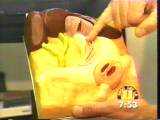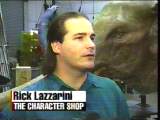|
Rick demonstrates how the wings of the chicken puppets
are articulated. "Lazzarini puts the same love and care
into each of his creations, whether they are cartoony or
realistic." Rick shows us a bass fish puppet that was
created for a beer commercial. The commercial features a
baseball game being played with the fish instead of a
baseball. We see a clip from that commercial. Rick
explains what different movements were built into the
puppet; tail waggles, eyes pop out, gills pop out, and
mouth opens. "But in the midst of this menagerie, The Character
Shop is embarking on a new direction." Rick shows his
different models, a suture model, and a hernia model.
Rick's models are being used by surgeons to practice the
difficult task of micro surgery. Dr. Stephen Shapiro
feels that this is Rick's best work. Dr. Steven Shapiro
trains surgeons in the latest micro surgery techniques.
In the past, micro surgery was practiced on live pigs. We
see Dr. Shapiro demonstrate the use of the model. He
works on the model through a special trainer box, and we
can see him making stitches, on a video monitor.
Lazzarini's models are so life-like that real animals can
be spared. Dr. Shapiro explains how Rick developed models of the
stomach and the esophagus. He states how Rick simulates
the feel of the actual tissue; we can see on the model
how soft and flexible it is. "They are so life-like that
they are being used around the world, which makes
Lazzarini proud." "We are usually creating something to
entertain somebody, or sell a product; in the case of the
medical models, we use the same techniques and materials,
but we're indirectly helping to heal someone", Lazzarini
states. "There's something a bit more ennobling about
that." Rick demonstrates how doctors would plastic surgery
endoscopically with a head model with a removable face.
We see a model of a knee, which will be used to train
doctors for endoscopic knee surgery. Tom Linden interviews Dr. Stephen Shapiro live. He
asks the doctor how they practiced the training before
the models were created. Dr. Shapiro explains that the
training was practiced on animals. "There is a whole
curricula of training for both the attending surgeon, and
the resin surgeon. The curricula includes a more
experienced surgeon, proctoring, and scrubbing with the
less experienced surgeon, so that the patient is operated
on safely." Linden asks Dr. Shapiro to show and explain
the models he has brought. He shows us a model designed
and manufactured by The Character Shop, and defines its
anatomy. "We see the liver which looks deep red in color.
The green, roundish object in the middle is the gall
bladder. We see the cystic duct, which is the duct that
connects the gall bladder to the common duct. Bile is
made from the liver, and goes into the intestines through
that duct." Linden explains: "The most common problem with this
part of the anatomy are stones, which would need to be
removed, or have the bile removed. Many patients get
stones in their common duct and this model helps the
doctors improve their technique in removing those stones
from the duct." Linden asks Dr. Shapiro to explain how
this model is used. Stones are placed in the model
through the back, and then the model is placed in a
trainer box. Then a tube with a small camera is placed in
the cystic duct, and the surgeons use tiny tools to
remove the stones. By placing the tiny optic tube into
the model of the cystic duct, doctors have a sense of the
human body without the need to practice on humans. "4-6
hours of practice on the model will get the surgeon ready
to go right into a person safely." Rick explains how different it is to make a puppet for
a movie, versus making a medical model. "When we make a
puppet for a movie, we have to make it look good on the
outside. But when we when we do the medical models, we
have to make them look good on the inside". "The
models are anatomically correct", Dr. Bruce explains,
"they are used to practice on for many different
operations." We see Character Shop employees working on
two severed heads. Dr. Shapiro lists all the different
types of surgery that the models are used for; general
surgery, plastic surgery, gynecological surgery, and
orthopedic surgery. Dr. Hensel expounds on what the
future of medical technology may bring us. "Doctors have turned to Rick and his crew to create
life-like models to practice surgery." Rick explains how
you need to have materials that are flesh-like, and how
no one knows about that better than special effects
practitioners. "You need materials that simulate flesh
realistically", Rick states. "Dr. Stephen Shapiro and Dr.
Leo Gordon recruited Rick Lazzarini to craft their models
for endoscopic practice." Dr. Shapiro explains with one
of his models, how a certain material is made to simulate
a certain part of the body. Rick had to experiment with
twenty-seven types of materials until the doctors found
one that felt right. Once complete, the model is placed
in a special training box. The Doctors use the same tools
that they would use to perform the surgery. Doctors watch
their movements with tiny TV cameras inside the body,
which transmit those images on a nearby video screen. Dr.
Gordon states: "This is the cheapest way for the surgeon
to learn the skill". This technique is more beneficial to
the patient, who is left with small scars, is more
comfortable, and recovers quickly."
What's New | Features
| Commercials | Resume
| Realistic | Whimsical
| Scary | Animatronics
Prosthetics | Puppets
| Publicity | Waldo®
| TCS Fun | FX
FAQ | Feedback | Reference Except where noted, all contents
are the property of The Character Shop, Inc. and copyright
1995-98

"You've seen many of his creations on TV and in
the movies, now see how this special effects wizard keeps
the medical field on the cutting edge." We see Rick
demonstrating his Waldo®
invention. Inside this converted warehouse in Canoga
Park, this modern day magician takes steel and plastic
and makes them approximate life. "You find the genius
behind what makes living things work, and how they work",
says Rick. This is the part he enjoys about making these
things. Rick demonstrates the large dog head from the
movie "The Sandlot". We see a clip of the part of that
movie in which this puppet is used. Then we see a clip
from the Foster Farms Chickens commercial.

"Imagine a surgery that is less painful, leaves
less scars, and reduces recuperation time." Medical
editor Tom Linden explains how endoscopic surgery works.
It is basically surgery without a knife. It is performed
through small holes in the body, and uses tiny TV cameras
that transmit images to a video screen, allowing the
doctors to see their movements to perform surgery. The
breakthrough is the use of specially designed models to
help doctors practice the technique.

"Hollywood special effects have now made it to
the operating table", says Dr. Bruce Hensel, M.D.,
explaining how the models help refine surgery. After
viewing a few brief clips from some effects-oriented
films, we see inside the workshop of Rick Lazzarini. We
see shop artists sculpting and painting different
projects. Dr. Stephen Shapiro explains: "The doctors
learn to cut specific muscles to move the brow upwardly
to decrease scarring."

Beginning with a few clips from Ghostbusters II,
the reporter asks how the creatures from that movie can
help doctors improve surgery techniques. "With the
breakthrough of endoscopic surgery, patients have less
pain, less scars, and shorter hospital stays." The camera
catches a wide shot of the inside of Rick Lazzarini's
Character Shop. We see employees working on an elephant
head for Disney's Operation Dumbo Drop. "The
Character Shop makes creatures for movies and TV, from
large, life-size elephants to mini-animatronic reindeer."
We see clips from different commercials, from the Foster
Farms Chickens to the Miller Surfing cow. Rick Lazzarini
is introduced, and he shows some of his creations from
past projects; the Sarah Jessica Parker and the Bette
Midler puppets from Disney's Hocus Pocus, and
several severed heads from the movie Ghostbusters
II. We see that famous clip of our ghostbusting
heroes in the underground train station as they are
confronted by a gaggle of gruesome heads.
Home